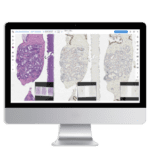More and more industry experts are discussing the importance of transitioning to digital pathology. However, there are many hurdles to financial investments on the path to a digital workflow. One frequent question is: is it worth it for me? Perhaps, perhaps not. However, it’s worth looking into some of the claimed benefits to help you more confidently make a decision.
1. Reduced Errors
Digital pathology reduces the transportation of slides, eliminating the risk of breakage during transport. Artificial intelligence and machine learning can help identify microscopic foci of interest, many “needle in a haystack” findings, and help gain consistency with tools such as automated Gleason scoring.
2. Enhanced Efficiency
The blend of new tissue-handling technology with digital solutions can create a more efficient pathology workflow. Some pathologists have been able to diagnose specimens measurably faster with Lumea’s tech. Labs can consolidate resources since there is no need for co-locating pathologists. Also, first-in, first-out workflow in the lab can save time and labor by avoiding the need to keep cases “intact” at multiple points in the process – the software reconstructs the cases for the pathologist at sign out.
3. Improved Distribution
Digital scanning enables the automatic sorting of the slides to the correct pathologist when they need it. Slides can be shared, transferred, and sent out immediately to any location on Earth.
4. Better Views
Previously, pathologists were limited to what a microscope could and could not do. Although most scanned images do not include the full thickness of the tissue section (z plane), digital slide viewers allow for more flexibility. For example, Lumea is developing MultiView®, which allows for real-time scanning/magnifying of multiple levels of the same tissue, even including special stains!
5. Increased Flexibility
Pathologists can choose the best appropriate location for their signout with digital pathology and have remote access to slides/recuts/special stains online as fast as the lab scanner uploads them versus waiting for a once-per-day courier or mail service. Enjoy a more flexible work schedule and eliminate the need for a commute.
6. Faster Turnaround Time
While scanning is an added step in the process, your turnaround time should improve if you work in a different location than the lab. There is also less time spent retrieving, data matching, and organizing. Expedited second opinions from colleagues and experts can be immediate through the cloud
7. Opportunity for Growth
Digital pathology can enable underserved areas in the US and abroad to get the medical care they need. Practices can extend to broader geographies, possibly opening new business opportunities as providers of second opinions or even primary diagnosticians. Many hospitals and outpatient clinical practices have difficulty staffing for pathology.
8. Ergonomic Improvements
Reduce or eliminate neck pain because you don’t need to bend over a microscope all day. Digital pathology can be more ergonomic than traditional pathology. In addition, you can potentially reduce eye strain by working from a properly-configured screen rather than a microscope. Consider purchasing blue light glasses (there are prescription and non-prescription options) or other screen covers while working at your computer to protect your eyes.
9. Save Administrative Time
Some digital pathology software automates or more easily facilitates administrative reports, billing, codes, and more. There will also be a significant reduction in glass slide management since scanned slides can be automatically and/or digitally sorted to the correct pathologist.
10. Elevated Patient Care
Data storage allows for long-term predictive analytics for patients. Artificial intelligence also provides opportunities to advance targeted therapies and digital genetic testing. Machine learning can detect patterns that humans cannot. Algorithms can analyze and compare millions of specimens and are identifying previously unknown patterns that may correlate with key molecular events that affect therapy and prognosis. In the future, these AI applications will completely revolutionize diagnostic medicine and save lives.
These are only some of the many benefits of digital pathology. If you haven’t made the switch yet, what is the one thing holding you back? If you have, what is your favorite benefit of digital pathology? We’d love to hear from you.
If you’re interested in trying out a low-effort switch, Lumea may have the digital pathology solution for you. Our tech plugs right into your existing LIS so you can start practicing digitally as soon as possible. Request a free demo to see if we’re the right fit for you.


